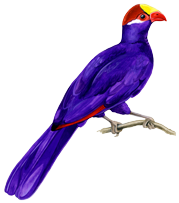 |
||

|
The Violet Turaco, Musophaga violacea; with open wings the scarlet of the flight-feathers is striking. Not wholly dependent on climax forest but certainly typical of it – the reason the bird was chosen locally for the logo of Farasuto Forest Community Nature Reserve |
Forest obligate birds
The West African Primary Coastal Forests
Farasuto’s forest, just 3.8ha in extent, is perhaps the smallest relict patch of primary coastal forest left in The Gambia and despite its small size still manages to support 12 of the 18 forest obligate bird species known from the country.
Primary Forest
That which has been growing on the particular piece of ground for very long periods of time – certainly several centuries and probably a great deal longer.
Secondary woodland
In contrast this is tree cover which has grown up after primary forest has been removed.
West African Primary Coastal Forest
This is a particular type of primary forest and is restricted in its distribution to the coastal areas of West Africa, largely within 100 miles of so of the sea. It is made special by not only the particular kinds of trees and other plants of which it is constructed but also the often different kinds of animals which live there, from special snails, spiders and butterflies to mammals and birds. This high variety gives primary forests, worldwide, their high biodiversity.
Secondary woodland, in contrast, having lost its connection to the plants and animals of the primary forest, supports a fraction of its variety and has a much lower biodiversity.
Primary coastal forest used to occur as almost continuous cover across The Gambia’s Western Division. However during the last century the need for land for farming and development and the need for wood for building and fuel plus the pure pressure of life has lead to the destruction of most of the country’s primary coastal forest. Evidence remains in the now isolated relict trees where once they were surrounded by forest – sometimes giant trees and sometimes smaller ones old, twisted and mis-shapen from their early forest life but still offering shade to villagers, travellers and traders alike – see photographs.
In a few places in the west of The Gambia there are patches of relict coastal primary forest – bits of primary coastal forest which remain, by accident or design, among a landscape now farmed or urbanised. These relicts, perhaps a dozen of them and none very large, still comprise the original trees and other plants while among them live many of the special forest animals managing to survive there. Abuko Forest, the largest relict coastal forest patch, is well known and is said to be The Gambia's most visited tourist attraction.
Many, though certainly not all, the animals of coastal primary forest are very different from those which live outside it, be they spiders, worms, snails, butterflies, monkeys or birds. Within the forest the conditions are different from those outside – generally wetter, soils deeper, the forest darker and the plant and the available animal foods are different. Organisms which are so adapted to live within the forest that they cannot, or at least do not, occur outside it, are obliged to remain within it – and they are known as forest obligates.
A great deal is known about The Gambia’s birds but rather less is known about the country’s forest obligate birds. We do know that out of over 500 species of bird recorded in The Gambia just 18 are forest obligates, never to be seen outside the forests. The number of forest obligate birds still living in a relict forest patch is a measure of its interest, its importance and its value. So for example Abuko forest, The Gambia’s largest relict forest patch (covering about 40 hectares or 100 acres), still supports 15 of the 18 forest obligate bird species, that is most of them, reflecting its high value. Abuko will also support high numbers of forest obligate spiders, butterflies and beetles for example, though less is currently known about them.
Farasuto’s forest covers only 3.8ha (9 acres) and is possibly the smallest relict forest in The Gambia. It survives by accident – when the surrounding forest was cut down, as recently as the 1960s, Farasuto was left because it was then (not now) used for traditional circumcision ceremonies. Small as it is Farasuto’s forest has records of no fewer than 12 of the 18 forest obligates – quite staggering for such a tiny relict.
Survey work in 2009 will look at the forest’s tree and other plants, its reptiles, butterflies, dragonflies, small mammals and other groups, if we can find the specialists with the time and skills to locate and identify them. Forest obligates in there groups will no doubt be found. The Management Plan to be produced in April 2010 will address the issues of the long-term future for Farasuto, particularly its expansion back onto adjacent land.
The forest obligate bird species known to occur in Farasuto’s forest are as follows:
One by one … to follow


